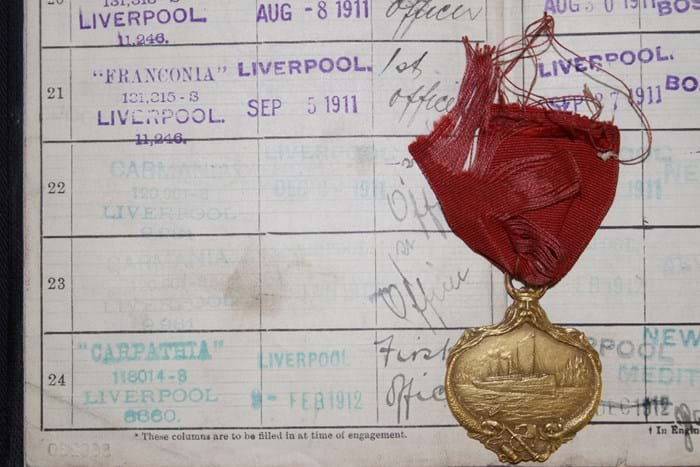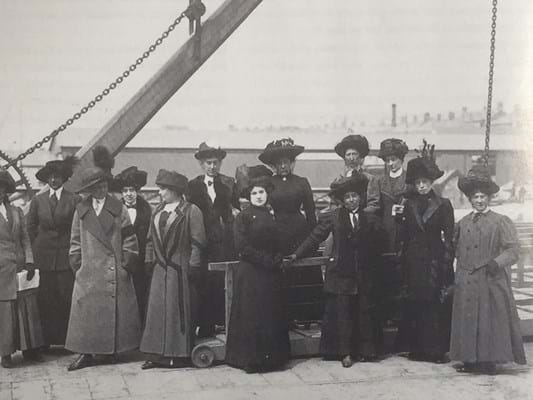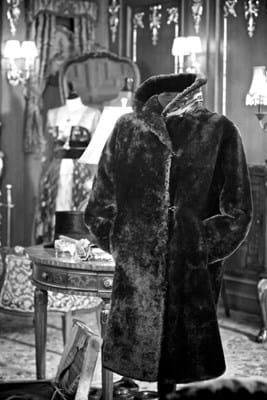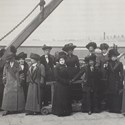It belonged to first class stewardess Mabel Bennett, who in fact was wearing it as she escaped the 1912 sinking which cost 1490 lives.
At Wiltshire saleroom Henry Aldridge & Son on April 22 it sold for a hammer price of £150,000 (plus 20% buyer's premium) against an estimate of £50,000-80,000. Buyers from the UK, US and mainland Europe competed and it eventually went to a UK collector.
In the Titanic collecting world there are all kinds of records to be set, depending on the specific type of memorabilia offered. In this case, auctioneer Andrew Aldridge says this fur coat result was “a world record price for an item from a member of Titanic’s crew and the third highest price for a piece of Titanic memorabilia of all time”.
It shows that five years on from the centenary year of the great liner’s sinking enough collectors are still out there and prepared to pay big sums for the rarest and most desirable items.
Coat provenance is key
Mabel Bennett’s coat first appeared at auction when it sold at Henry Aldridge in 1999. Provenance is key when it comes to Titanic memorabilia and the coat had a solid backstory.
It had remained in the family until that sale and was accompanied by a letter of provenance from her great-niece saying: “On her rescue from the Titanic she was in her nightdress and this coat was the first garment she snatched for warmth. My aunt gave me the coat in the early ‘60s, because of her advancing years she found the weight of the coat too much for her.”
Bennett signed on to Titanic as a stewardess on April 6, 1912, having previously worked as a stewardess on Olympic. At her launch in 1912, Titanic was the world’s largest ship - the second of three huge liners including the Olympic (1911) and Britannic (1914). They were built by the White Star Line to carry passengers across the Atlantic Ocean to the US.
Bennett's brother-in-law and nephew, Alfred Crawford and Leonard James Hoare, respectively, served on board Titanic with her. Her nephew was lost in the sinking but her brother-in-law was saved.
While a trio of relatives serving on board the ship at the same time is noteworthy in itself, Bennett is also known for being one of the longest living, if not the longest living, female member of the crew, dying at the age of 95.
Bennett wore this heavy coat for protection from the cold as she boarded Lifeboat No5 and embarked on Carpathia (the only ship to reach Titanic survivors). She also wore it aboard the Red Star Line SS Lapland which had been used by White Star Line to transport Titanic’s crew back to England.
The lot was accompanied by a copy of a photograph of Bennett on the deck of the Lapland for the return voyage to Plymouth pictured with other Titanic stewardesses in which she can be seen wearing this very coat.
Carpathia rescue medal

An “extremely rare” Dieges and Clust gold Carpathia medal awarded to Horace John Dean, first officer of the Carpathia, which sold to an American collector for £35,000 (estimate: £25,000-30,000) at the Henry Aldridge & Son auction on April 22.
Another star of the April 22 sale was an “extremely rare” Dieges and Clust gold Carpathia medal awarded to Horace John Dean, first officer of the Carpathia, which sold to an American collector bidding on the phone for a mid-estimate £29,000.
The medals were awarded for the rescue in the same year to officers and men, in gold (14 medals), silver (110) and bronze (180) according to rank.
Of the gold medals, awarded to the most senior Carpathia crew members, Andrew Aldridge says “only a handful have ever been sold at auction and none from such a senior officer”. Dean’s is the third-highest ranking Carpathia gold.
He adds: “What made this medal even more remarkable was that First Officer Dean's continuous certificates of discharge accompanied it. They documented his career on the high seas - a first for a medal of this importance. The all-important entry for Carpathia’s rescue voyage is the 24th in his second book with Captain Rostron listed as Master with stamped signature.”
The 42-year-old Arthur Rostron had been an officer with Cunard since 1895 and master of Carpathia for just three months when the 711 Titanic survivors were picked up.
Poor old Carpathia herself also suffered an untimely end: falling victim to a German torpedo in 1918.
The Titanic collecting market
While dedicated auctions for coins and medals are common now, and one-off specialist dedicated sales in certain areas often appear, it does seems incredible that the Henry Aldridge saleroom continues to hold two Titanic sales a year.
However, Andrew says: “As with everything, there is material that is recycled from collectors, and then fresh material from family members from survivors. There is still fresh stuff but getting a lot thinner on the ground, so it is basically supply and demand because of that."
He points out that as the Titanic sales have been held since 1998, many items reappearing did so quite a long time ago now, such as the fur coat.
Andrew adds that the market is also "a wholly different animal to what it was then".
"Certain things have gone up exponentially, but other things have actually dropped. For example, if you had bought some china 20 years ago the probability is you'd paid more than it is worth now, but there is a very hard core of about 12-15 high-end buyers who are happy at six-figures plus.
"You have that hard core and then, as I call the the 'curve balls' who appear. In the run-up to these sales we always get very good publicity and you'll get someone new bidding because of that. For instance the Carpathia medal that sold was on the back of someone seeing it on Fox in the US."
Another factor allowing two sales a year is including other 'iconic' 20th century items alongside Titanic, although Titanic remains very much the 'headline act', says Andrew. About 18 months ago the saleroom's Fire and Ice sale included Hindenburg airship memorabilia.









